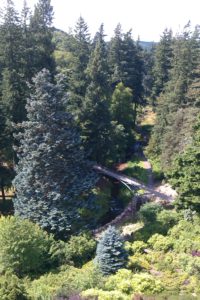Over the past two weeks I’ve made a couple of trips up to one of our partner houses, Cragside, near Rothbury in Northumberland. I’ve met members of staff (including Katherine the house steward and Andrew the curator, both of whom have been very friendly and helpful), found things to film for the digital interactive (on which more here) and decided on electrical items to be animated for use around the house.
The digital interactive will tell the story of all three of our partner houses, drawing out common themes in the history of electrification as noted in the Principal Investigator Graeme Gooday’s book, Domesticating Electricity, on which this project is based. These themes will include the aesthetics of electric lighting, how electricity was used for communication, and how early electrical lighting systems were often unreliable. Where possible, we intend to illustrate these themes, and rooms in the houses to which they relate, with video footage, so it was important to look around and see what we should film. Here I was grateful to have my friend and colleague Paul with me taking photographs, while I furiously scribbled partially legible notes on my little pad.
For example, did you know Cragside has two electric dinner gongs upstairs, which were operated by the butler from downstairs to let everyone know it was time for tea? The house was so big you wouldn’t have heard the normal gong at the bottom of the stairs! The old fire alarms are also a very practical and a very attractive technology, especially the one installed in the Owl Suite of bedrooms, where the Prince and Princess of Wales and their children stayed whilst staying at Cragside in August 1884. I can imagine it might have been a little too easy to set these off by accident though!
The animations we will produce will be cartoon-style explanations of various electrical items and systems around the house and wider estate. They will be used on tablets by volunteers and staff to show to visitors. For example, in the library are four vases which were originally oil lamps, but were converted over to use Joseph Swan’s lightbulbs in 1880, making them some of the very first such electric lamps. As there was no effective electric lightswitch yet, these lamps sat on a base which contained a small cup of mercury. When the wire which came down from the bulb through the vase dipped into the mercury, the lamps lit up; when the vases were moved, the bulbs went out. I don’t think you’d want one of those in your house today! We will also be animating the hydroelectric system to demonstrate how it worked, as well as the telephone system which was used by the butler to regulate the supply of electricity to the house.

Blessed with lovely weather on both of my visits, it was very useful to walk around the grounds and get a feel for the layout and the scale of the estate. On my second visit, with Graeme Gooday, the curator Andrew took us up to the top of the house to the tower, not normally seen by visitors. The view was fantastic. I also need to thank Andrew in particular for the treasure trove of primary sources he’s given me to read through, and which I’m very grateful to have. Over the course of the project I hope that maybe I can add to this, possibly by going through volumes of old electrical journals like the Electrician and the Telegraphic Journal and Electrical Review to find references to Cragside and Lord Armstrong from the 1880s and 1890s.
Later, Mark, the Cragside representative on the project, and Andrew took Graeme and myself up to the lake at the top of the hill. Armstrong had this lake built around 1886 to provide a supply of water for the turbine which, connected to a dynamo, provided electricity to light the house. This was the second major stage in a project which had begun at the other end of the estate in around 1878; however, the original hydroelectric generating system had been too far from the house and wasn’t efficient enough to deal with the increasing demand as Armstrong installed more lights, so he built a second, closer, generating system.
As you can just about make out from the photo, the view of the otherwise idyllic landscape also includes a couple of electricity pylons lurking in the background, marching their wires across the rolling hills. Some might consider this a rather unfortunate juxtaposition of natural beauty and artificial unsightliness. However, as Andrew pointed out, given Lord Armstrong’s passion for electrification, and pioneering efforts in providing electricity at a distance, maybe this symbol of progress and electrical infrastructure, forming the backdrop to a view of Armstrong’s own early attempts, is really rather appropriate.
I came back from Cragside with plenty to think about, and lots of notes, primary sources and photographs. I’m looking forward to sorting through everything and to doing the filming in early August. In the meantime, here is a photo, taken on the main staircase at the end of our visit by a very patient member of staff, of Paul and myself wearing funny hats. You’re welcome.



